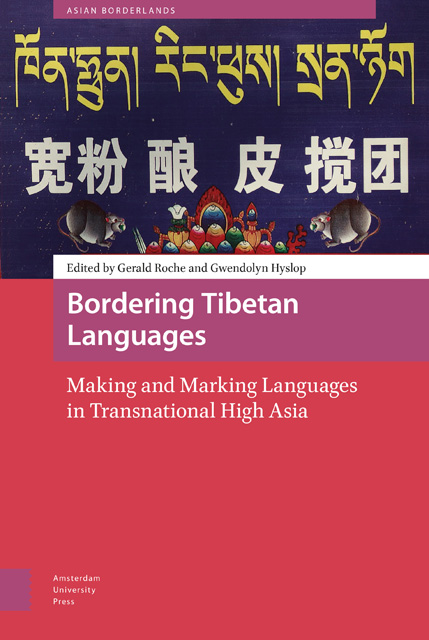Book contents
- Frontmatter
- Table of Contents
- Acknowledgements
- About the Cover Image
- 1 Introduction: Bordering Tibetan Languages: Making and Marking Languages in Transnational High Asia
- 2 Playing with Language Boundaries: Heteroglot Standard Language Ideology and Linguistic Belonging among Amdo Children
- 3 The Role of Classical Tibetan (Chöke) on the Development of Kurtöp, a Language of Bhutan
- 4 Reimagining Rongring without Tibetan Buddhist Influence
- 5 Glottonyms, Identity, and Language Recognition in the Eastern Tibetosphere
- 6 On the Yak Horns of a Dilemma: Diverging Standards in Diaspora Tibetan
- 7 Changing Identity and Linguistic Practices in Nubri: Veiled Language Endangerment in the Nepalese Tibetosphere
- 8 Borderline Dominance: Transnational Tibetan Language Politics in the Himalayas
- 9 Borders: In Conclusion
- Tibetan Language Summaries
- Asian Borderlands
- Index
5 - Glottonyms, Identity, and Language Recognition in the Eastern Tibetosphere
Published online by Cambridge University Press: 24 November 2022
- Frontmatter
- Table of Contents
- Acknowledgements
- About the Cover Image
- 1 Introduction: Bordering Tibetan Languages: Making and Marking Languages in Transnational High Asia
- 2 Playing with Language Boundaries: Heteroglot Standard Language Ideology and Linguistic Belonging among Amdo Children
- 3 The Role of Classical Tibetan (Chöke) on the Development of Kurtöp, a Language of Bhutan
- 4 Reimagining Rongring without Tibetan Buddhist Influence
- 5 Glottonyms, Identity, and Language Recognition in the Eastern Tibetosphere
- 6 On the Yak Horns of a Dilemma: Diverging Standards in Diaspora Tibetan
- 7 Changing Identity and Linguistic Practices in Nubri: Veiled Language Endangerment in the Nepalese Tibetosphere
- 8 Borderline Dominance: Transnational Tibetan Language Politics in the Himalayas
- 9 Borders: In Conclusion
- Tibetan Language Summaries
- Asian Borderlands
- Index
Summary
Abstract
This chapter examines issues of language naming and language recognition practised by local Tibetans and scholars in the eastern Tibetosphere and discusses how and why Tibetans border their various speeches actively by naming them in various ways. It focuses on three cases: ‘Tibetic’, ‘logs-skad’, and ‘mixed language’ as separate instantiations of language recognition. Firstly, the term ‘Tibetic’ triggers controversy both amongst linguists and between linguists and the Tibetan community. Secondly, the use of the Tibetan term ‘logs-skad’ marks the recognition of unintelligible speeches to mainstream Tibetans. Thirdly, the label of ‘mixed language’ can be a crucial part of speakers’ identity. The chapter argues that linguists have a responsibility to balance their commitments to specificity with Tibetans’ practice of naming languages.
Keywords: naming, language recognition, language classification, Khams, Tibeto-Burman
Introduction
Language names in the eastern Tibetosphere have long been discussed by academics as well as Tibetans. Naming both makes and marks a boundary between a designated object and others; language names thus produce specificity and separation. In this chapter, I focus on a variety of language names and their places with systems of language classifications in the eastern Tibetosphere. These names include those used by scholars and members of local communities: ‘Tibetic’, ‘logs skad ལོགས ་ སྐད་ ‘, ‘Minyag’, ‘Lamo’, and ‘Selibu’. In discussing these names, I explore how these labels operate as means for Tibetans to engage in recognition and bordering; I also examine how scholars working in this area have considered language names and how they might respond to Tibetan ways of recognising and labelling languages.
Linguists generally recognise a language by giving it an independent name, that is, a glottonym. Glottonyms can be considered as proper names in their meaning and function (see Zink, 1963; Katz, 1977; Van Langendonck, 2008). Numerous debates around glottonyms exist, because these labels are typically not uniformly determined, and several different names may be provided for a single language or a language group, as seen in the entries of the widely used linguistic reference work, the Ethnologue (Eberhard et al., 2019).
- Type
- Chapter
- Information
- Bordering Tibetan LanguagesMaking and Marking Languages in Transnational High Asia, pp. 105 - 126Publisher: Amsterdam University PressPrint publication year: 2022



